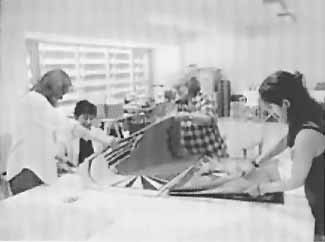 |
|
|
Benaki's New Wing Provides a Valuable Repository of Historical Data |
|
| The Benaki Museum's Modem Greek Architectural Archive now houses blueprints, photographs, entire libraries and rare original documents recording the development of Greek architecture since the 19th century. Located on the first floor and basement of the Benaki's impressive new building on 138 Pireos Street, the new space is pleasant and functional, modem, minimalist, roomy and well-lit. Four women manage the archive, all of them architects, headed by Maro Kardamitsi-Adami, associate professor at the National Technical University of Athens and one of the most well-known and competent researchers in the subject. The team is completed by Natalia Boura, Margarita Sakka- Thi vaiou and Leti Krokou-Arvaniti. The aroma of old paper blends with technology and modern archive techniques to create a channel of communication with the public. "Living architects or the descendants of those who are no longer alive have given us material that has provided us with a continuous architectural history of Greece," said Kardamitsi-Adami. |
|
 Four Female architects run the Modern Greek Architeture Archive at the new Benaki venue on Pireos Street |
The archive includes the work of many 20th century professors of architecture, such as Ioannis Despotopoulos, Yiannis Liapis and Solon Kydoniatis. Other entries include the archives of Academy member Pavlos Mylonas (including his complete study of Mount Athos), the files of the National Tourism Organization on Greece's "Xenia" hotel chain, the archives of architects Constantine Kapsabelis and Kyriakos Sfaellos (who were active during the 1950s), the archives of the Ministry for Reconstruction in the first years after World War II, the archives of overseas Greeks such as Yiannis Mytarakis, the first women architects (the pioneering Marika Zagorisiou and Alexandra Moreti), the engineer Hadzipanayiotou, and younger architects active since the war such as Anastasia Tzakou and Dimitris and Suzanna Antonakakis. "We welcome all contributions, whether it is an entire archive or just a photograph or piece of verbal information," the organizers said. |
|
Many architectural archives have been destroyed or are missing simply because the owner's descendants do not realize their value or cannot imagine the archives could be included in an information and research network such as the one at the Benaki.
"Architects are essentially modest people," said Kardamitsi-Adami. "Very few think their work is something worth keeping." A strong point of the Benaki Museum's architectural archive is its information on the 1930s generation. Most people don't know about this time period, even though it represents one of Greek architecture's brightest eras. The museum has catalogued complete or partial archives, architects' photographs and personal libraries. |
|
|
HCS readers may wish to view other articles and releases in our permanent, extensive archives at the URL http://www.helleniccomserve.com/contents.html. |
|
|
|
|
|
2000 © Hellenic Communication Service, L.L.C. All Rights Reserved. http://www.HellenicComServe.com |
|
